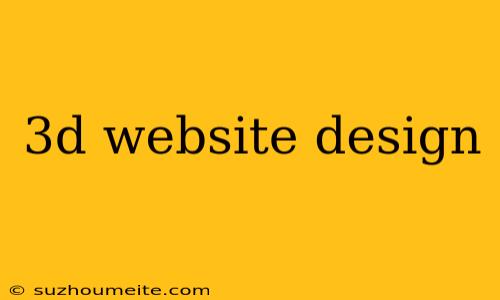3D Website Design: The Future of Online Interaction
Introduction
In recent years, the web design landscape has undergone a significant transformation. With the advent of new technologies and innovative design trends, websites have evolved from static, 2D platforms to immersive, interactive experiences. One of the most exciting developments in this space is 3D website design, which is revolutionizing the way we interact with online content.
What is 3D Website Design?
3D website design involves creating a three-dimensional environment that simulates real-world interactions. This can include interactive 3D models, virtual reality (VR) experiences, and augmented reality (AR) integrations. By leveraging advanced technologies like WebGL, Three.js, and A-Frame, designers can create immersive, interactive websites that engage users like never before.
Benefits of 3D Website Design
Enhanced User Experience
3D website design offers an unparalleled level of interactivity, allowing users to explore and engage with online content in a more immersive way. This can lead to increased user engagement, longer session times, and higher conversion rates.
Improved Storytelling
3D website design enables designers to tell stories in a more dynamic, interactive way. By creating 3D models, animations, and simulations, designers can convey complex information in a more engaging, easy-to-understand format.
Increased Conversions
Studies have shown that 3D website design can increase conversions by up to 25%. This is because 3D experiences are more memorable, engaging, and shareable, making users more likely to take action.
Types of 3D Website Design
Interactive 3D Models
Interactive 3D models allow users to rotate, zoom, and explore products or objects in 3D space. This is particularly useful for e-commerce sites, where users can interact with products before making a purchase.
Virtual Reality (VR) Experiences
VR experiences transport users into a fully immersive, computer-generated environment. This can be used to create engaging, interactive stories, simulations, or training experiences.
Augmented Reality (AR) Integrations
AR integrations overlay digital information onto the real world, enabling users to interact with virtual objects in their physical environment.
Challenges and Limitations
Technical Requirements
3D website design requires advanced technical expertise, including proficiency in programming languages like JavaScript and HTML5.
Browser Compatibility
Not all browsers support 3D website design, which can limit the reach and accessibility of 3D experiences.
Performance Issues
3D website design can be resource-intensive, which can lead to performance issues, slow loading times, and high bandwidth usage.
Conclusion
3D website design is an exciting, rapidly evolving field that has the potential to revolutionize the way we interact with online content. While there are challenges and limitations to consider, the benefits of 3D website design – including enhanced user experience, improved storytelling, and increased conversions – make it an attractive option for forward-thinking designers and businesses. As technology continues to advance, we can expect to see even more innovative, immersive 3D website designs in the future.
